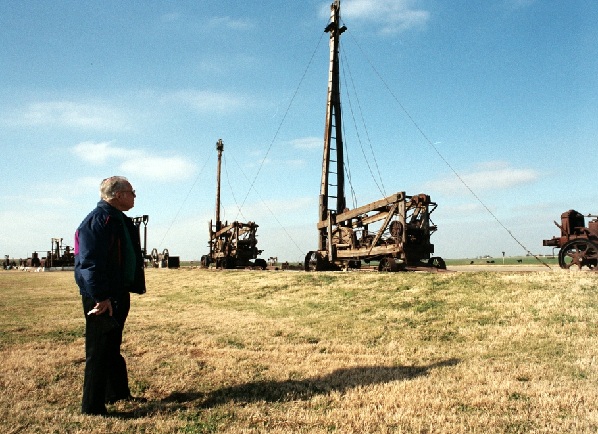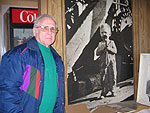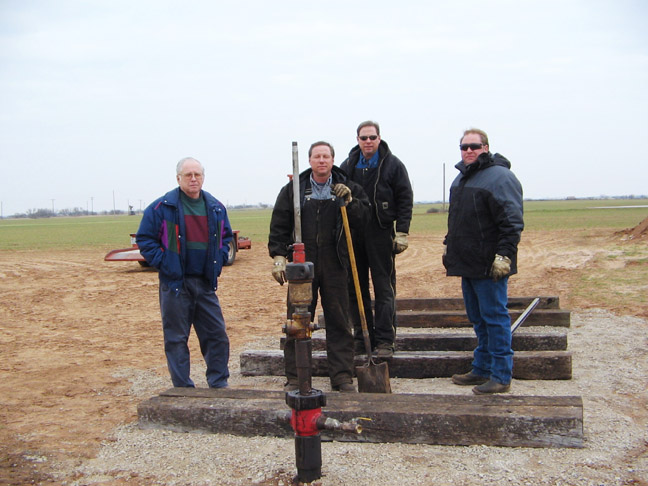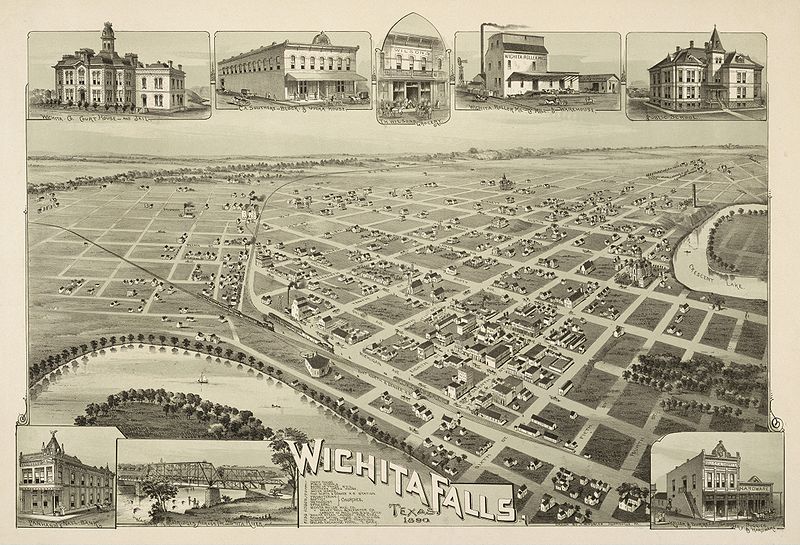North Texas petroleum history preserved by a dedicated Burkburnett independent producer.
Three generations of the Felty family have kicked historic Burkburnett oilfield mud from their boots while maintaining the Felty Outdoor Oil Museum. The first, Francis “F.T.” Felty Sr., worked in Wichita County through the revival of a North Texas drilling boom during World War Two. Responding to the war’s steel shortages, he crisscrossed oilfields in a truck pulling used casings. It turned into a long career in the oil patch.

With exhibits collected over many decades by Francis “F.T.” Sr., the Felty Outdoor Oil Museum of Burkburnett, Texas, has displayed machinery from the height of a 1918 North Texas oil boom. Portable cable-tool spudders were watched over by museum founder’s son, F.T. Felty, Jr. Photos by Bruce Wells.
When the senior Felty moved from salvaging and began drilling in the 1970s, it was within sight of the historic 1918 Burkburnett discovery well. He had begun collecting old oilfield equipment in the 1950s – and a lot of rocks, noted his son, Francis “F.T.” Felty Jr., owner of the F.T. Felty Operating Company.
The senior Felty died in 1981, well after introducing grandchildren to the oil patch, said F.T. Jr. His father also instilled in them the importance of preserving its history, he added. The family office and the “Felty Outdoor Oil Museum” are just off Interstate 44 about 15 miles north of Wichita Falls.

Francis “F.T.” Felty Jr., in 2004 stands by a photograph of himself “playing” on his father’s drilling rig.
The Felty leases are where the famous wells of 1918-1919 were drilled and regularly produced 800 to 1,500 barrels of oil a day with three barrels of saltwater.
The oilfield’s production has long since reversed. But with careful re-injection of the brine back into the sands below the 1,500-foot producing zone, hundreds of wells each yield a few barrels of oil daily.

F.T. Felty Jr. — and sons — at one of their wells in the Burkburnett oilfield, which was first discovered in 1918.
F.T. Sr. “put his money back into the ground,” said his son. “He kept at it, and bought a few more little leases around here, which are still in the family.” Three of F.T. Sr.’s grandsons have worked in the Burkburnett oil patch. A fourth was not far away, working for a bank in Dallas.
Felty Family Oil Museum
Along the gravel road marking the family’s property line northeast of Burkburnett stands a row of antique cable-tool spudders, oilfield engines – and a memorial plaque dedicated to family members. The displays flank a small building once home to an oilfield worker and now the family’s business office.
Nearby are rows of stacked drilling pipe and assorted oilfield equipment still in use. A modern spudder is parked by a large building, which Felty and his sons constructed to house still more equipment, heavy tools, and a machine shop.
A rock and concrete wall-monument painstakingly built over many years by the senior Felty, is part of the landscape near the Felty office and a popular stop for school buses filled with inquisitive students. The museum exhibits machinery from the acme of the oil boom, including truck-propelled spudders used for drilling and cleaning out wells, a steel beam pumping unit, and a band-wheel power source.
 The senior Felty started working at the Burkburnett bank while in high school. After becoming a cashier, he decided to go into the oil patch. F.T. Sr. began as a lease man for others, but eventually started his own business in casing-pulling.
The senior Felty started working at the Burkburnett bank while in high school. After becoming a cashier, he decided to go into the oil patch. F.T. Sr. began as a lease man for others, but eventually started his own business in casing-pulling.
In 1967, he bought several leases north of town, in the heart of the historic oilfield, and started production. At the time, the leases used old band wheels with rods lines, powered by a single engine and without electricity (learn more in
Eccentric Wheels and Jerk Lines).

“That rock and cement wall that dad put together over many years tells history from the Atlantic to the Pacific. The younger kids like it.”
F.T. Jr. maintained his father’s outdoor oil museum.
“He wanted a place where the old-timers could get out and walk around, reach out and touch equipment and bring back real memories,” F.T. said. “We have a lot of people who stop during the summer; the wives will stay in their air-conditioned cars, but the husbands will get out and walk up and down just to see these old relics from their oilfield days,” he added.
The Burkburnett Chamber of Commerce has hosted a “Tales and Trails” tour with the museum among the stops. “They come in by the busload of children for a 20-minute talk about the field’s history,” said F.T. “That rock and cement wall that dad put together over many years tells history from the Atlantic to the Pacific. The younger kids like it.”
The original Burkburnett oil strike occurred on S.L. Fowler’s farm on the Red River town founded in 1907 and named by President Theodore Roosevelt, who once hunted wolf nearby with rancher Burk Burnett.

Discovered on July 29, 1918, on S.L. Fowler’s farm, the giant oilfield brought thousands of people to the Central North Texas. Twenty trains ran between Burkburnett and Wichita Falls — every day.
Oil had been discovered nearby as early as 1912, but it was the 1918 Fowler discovery well that brought thousands to the town – with 200 wells completed in the following three months. By late 1918, Burkburnett wells were producing 7,500 barrels per day.

This lithograph from the Amon Carter Museum in Fort Worth depicts Wichita Falls in 1890.
About 20,000 people flowed into the region. Twenty trains ran daily between Burkburnett and Wichita Falls.
Eventually, of course, the oil boom died out. Affected by the Great Depression, Burkburnett’s population declined during the 1930s. By 1939, the town had a population of less than 3,500. Residents today number more than 10,000, thanks to agriculture and continued production from the historic oilfield. Among Burkburnett’s tourist attractions are the Bluebonnet Festival in April – and the Felty Outdoor Oil Museum.
For high-resolution panoramic images of the North Texas oilfield, visit the Library of Congress Prints and Photographs Division’s Burkburnett, Texas, “the world’s wonder oil pool, showing 8 months phenomenal development, viewed from the northwest side, opposite Fowler farm, original discovery well and swinging towards the northwest.”
____________________________________________________
AOGHS.org welcomes sponsors to preserve U.S. petroleum history. Please help maintain this energy education website by becoming a supporting membertoday. Contact bawells@aoghs.org for membership information. © 2020 Bruce A. Wells.
Citation Information – Article Title: “Felty Outdoor Oil Museum.” Author: Aoghs.org Editors. Website Name: American Oil & Gas Historical Society. URL: https://aoghs.org/energy-education-resources/felty-outdoor-oil-museum-burkburnett-texas. Last Updated: January 12, 2020. Original Published Date: March 11, 2005.

